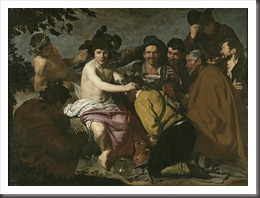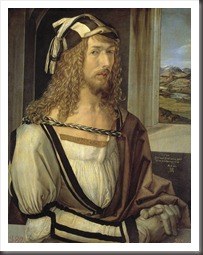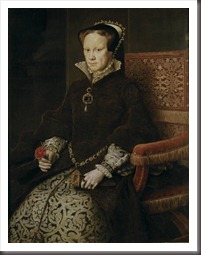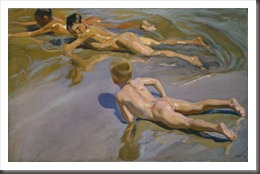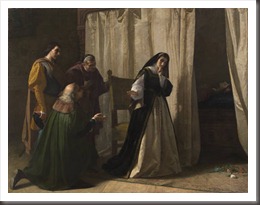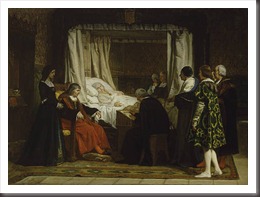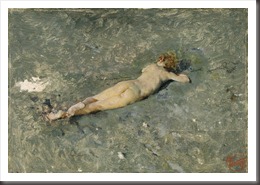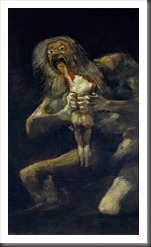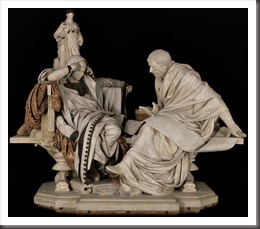Prado, My Selection
For fellow art-buffs like me, visiting museums is an exciting activity. Museums the size of Prado are mentally and physically demanding due to the sheer size of the collection. Knowing it is impossible to see and absorb it all, I was still anxious not to miss seeing the best known works in the museum. Prado provides a list of ‘masterpieces’ with its museum plan which I used and recommend. After my visit to the museum, I have made my own list of must-sees which I document here. I strongly recommend the Prado website which has most generously included detailed images which we students and admirers of art can use to examine details. I have linked my images to the detailed ones in Prado’s site, click to zoom in.
Strategy for visiting : The Prado is not as overwhelming in size as the Louvre or the Met yet the richness of the collection is equally impressive. The museum is free everyday between 6pm and 8pm except on Mondays when it is closed. Queue up by 5:45 to get in by 6:15. You will be ushered out by 7:50 so you will get an hour and half of visiting time. On Sundays, it is free from 5pm to 8pm so you get an hour extra. My total visit length was 7 hrs over 3 days; one weekday evening, one Sunday evening and one morning as a paid entrant (12Euro for Permanent Collection and Temporary Exhibitions combined). I managed to see two of the temporary exhibitions in this time, one on Ribera’s young period and one on Chardin, both excellent. If you speak Spanish or English, an audio guide is not necessary as there are explanations next to each painting. In 7 hrs (not counting rest breaks), I could see the temporary exhibitions in great detail, walked past every painting and lingered in front of about 5 % of the works on display.
Photography is not permitted in Prado; all images below are from their website.
Room : 9
Artist : Ribera (1591-1652)
Title : The Martyrdom of Saint Philip
Why: I have always loved Caravaggio and Ribera is a follower of his style, called a Tenebrosi or a shadow-painter. This painting is one of the best of his oeuvre; zoom in close to see the look of resignation in the Saint’s eyes, the concentration in the eyes of the man who is pulling him up, the curiosity in the eyes of the man watching at the right, the bunching of the muscles of the man with his back to us; the darkness of the clothes to the left of the saint and their lost edges bring the Saint’s body sharply in focus. The various vertical lines make us imagine the pull, the Saint’s contorted body makes us feel the pain. Fantastic!
Room : 10
Artist : Velazquéz (1599-1660)
Title : The Triumph of Bacchus
Why: Of all Spanish artists following Caraveggio’s style, Velazquéz is my favourite. In fact, after visiting the Prado, I am in mind to abandon Caraveggio (who was, after all, a rascal!) and transfer my affections to Velazquéz! See how one can almost touch the softness of Bacchus’s skin as also the coarseness of the drinkers around him! The artist uses light to make us focus on what he wants us to see.
Room : 11
Artist : Velazquéz (1599-1660)
Title : Vulcan’s Forge
Why : To admire Velazquéz ability to paint the male (semi) nude from all angles. To admire his ability to paint different textures from the softness of Vulcan’s robes to the coarseness of the other garments, the shine of steel vs. the shine of pottery but above all his mastery in portraying emotions. Look at all their faces !! The colours are subdued yet rich, especially on and around Vulcan. The artist paints a mythological theme in a very real and current manner.
Room : 12
Artist : Velazquéz (1599-1660)
Title : The Meninas
Why: Because it is THE masterpiece of the museum. Most of all because when you stand in front of it, the painting literally glows as if there is light emanating from it !! Do not forget to admire Velazquéz’s self portrait and the small reflected portraits of the regents in the mirror.
Room : 15a
Artist : Velazquéz (1599-1660)
Title : Mercury and Argos
Why : I always fall in love with one painting or the other in galleries and want to take them home! And at Prado, this is the one. I cannot explain why; certainly its not a celebrated work of the artist. Because of the perfection of the slump of Argos’s body? Because of the looseness and fluidity of the brushwork? It all has this unfocused look..yet we know something more is going to happen by the slight lift to Mercury’s head. The feathers in his cap are just a few strokes of the brush, his face hidden in shadow – almost. The composition is very clever, it conveys a hidden energy. My heart is given to Velazquéz for the expertise needed to state yet not state, to draw and withdraw, to stabilize and move – all at the same time!
Room : 16b
Artist : Van Dyck (1599-1641)
Title : Crown of Thorns
Why: The artist painted this when he was only about 20!! If this is not genius, what is? I, who struggle with my brushes in my advanced years to capture light and shade just so, feel a flash of envy when I see how well the forms are sculpted. Zoom in to see how loose the brushstrokes actually are! The tiredness in the face of Jesus tugs at our hearts.
Room : 25
Artist : Rubens (1577-1640)
Title : The Three Graces
Why: A happy painting filled with the joy of life when other artists portrayed gloom and doom. Also explains the adjective ‘Rubenesque’ and makes excess flesh look seductive! Feel good picture for well-endowed women..
Artist : Rubens (1577-1640)
Title : Saturn devouring his son
Why : To compare and contrast with Goya’s famous painting on the same subject. To compare and contrast with the joyful picture of the three graces by the same artist. Look at the loose edges at the shoulder which create a sense of movement and the red-rimmed eyes adding to the horror of the scene.
Room : 26A
Artist : Durer (1471-1528)
Title : Self Portrait
Why : His famous Adam and Even is in Prado too but I select this because there is a vulnerability and self-consciousness to his painting which is endearing. He is only 26..so young! There are no loose strokes here but great attention to detail. Zoom in to see how well the hair has been executed, as well as the little pleats on his shirt.
Room : 36
Artist : Goya (1746-1828)
Title : The Nude Maja
Why : This painting and its pair, the Clothed Maja, are truly striking. The sensuality of the form is matched by the invitation in the model’s eyes. Zoom in to see how the artist has added pearly-blue to the skin to reflect the white of the sheet. This lustre – this is what artists aim for!
Room : 49
Artist : Raphael (1483-1523)
Title : The Cardinal
Why : If you have seen the vast mythological pictures of this Italian artist in St. Peter’s, this almost intimate portrait comes as a surprise. The eyes make an instant connection across centuries. The red silk gleams and the white of the sleeve is brilliant yet we are drawn to the eyes. Zoom in to see how well the artist has modulated the face with invisible brushwork.
Room : 56
Artist : Mor (1545-1575)
Title : Mary, Queen of Scots
Why : Making us look at a beautiful woman, that’s one thing. But to make us stare and stare at a not so good looking woman, that takes mastery. Here, the Netherlandish artist has portrayed the sheer force of character which made Mary who she was. The material of her coat, her dress, the lace cuffs, the jewellery, the upholstering…everything has been done to perfection. But what I admire most is the modelling of the face to display the innate character – that is what portraiture is about.
Room : 56A
Artist : Bruegel The Elder (1525-1569)
Title : The Triumph of Death
Why : It’s only recently that I have become fascinated with this period of painting. Bruegel is a story-teller, illustrator and artist, all in one. In this picture, he displays a truly dark side which seems very Spanish (he is Flemish). It seems to me that the much later nightmarish works of Salvadore Dali would feel at home in the same room as this picture were in not for the sombre colours here.
Room : 58
Artist : Van Der Weyden (1400-1464)
Title : Descent from the Cross
Why : For the surprising 3D effect of this 15th century painting. For the fluidity of the composition. The attention to detail (zoom in to see the drops of tears in the faces!), the realism of the faces and the sumptuous colours make this painting extraordinary. A masterpiece!
Room : 60A
Artist : Sorolla (1863-1923)
Title : Boys on the Beach
Why : We jump across centuries to the Impressionistic period to admire this painting. The strokes are long and loose, the details missing. But that does not stop us from feeling the wet sand under our toes, enjoying the warmth of the sun and watching the children frolic.
Room : 61
Artist : Dominguez Sánchez (1840-1906)
Title : Seneca after opening his veins
Why : My trip to Prado introduced me to a number of Spanish artists with whom I had not been familiar before. This artist is amongst them and I was delighted to discover him. He uses Chiaroscuro but more gently than Caravaggio, Rembrandt or Velazquéz. His colours are much more vibrant but of course its a different period all together. The composition is clever – the leaning form of the grieving friend takes our eyes to Seneca whose arms lead us back to the griever through the flowing red material of the robe, thus focusing attention on the main players until our eyes stray to the others by a light here or a light there to examine their faces. The different attitudes of the grievers, the well-executed drapery and bodies and the expert lighting makes me a fan !
Room : 61
Artist : Vallés (1831-1910)
Title : The dementia of Juana of Castile
Why : Another artist whose work I was unfamiliar with before, who has adopted the chiaroscuro style with an extensive palette. Zoom in to see how perfectly every detail is executed – there are no loose strokes here. While older history paintings can look posed or stilted, both Dominguez Sanchez and Vallés have achieved a natural and realistic look. Noteworthy is the slightly mad look in Juana’s face. Beautiful!
Room : 61b
Artist : Rosales Gallina (1836-1873)
Title : Queen Isabel la Católica dictating her last Will and Testament
Why : Another historical painting, the execution is slightly more loose but its even more expressive. I loved the drama!
Room : 62
Artist : Fortuny Marsal (1838-1874)
Title : Nude at the beach at Portici
Why : I saw a few breathtaking watercolours and oils by Fortuny and his followers. I am not at all sure why Fortuny is not more celebrated as an artist. Very impressionistic, the swirls of the brushwork are clearly visible when you zoom in. Look at his treatment of the hair. The artist has captured light in his painting!
Room : 62A
Artist : Sorolla (1863-1923)
Title : And they still say fish are expensive!
Why: I am more familiar with the light filled joyful impressionistic works of Sorolla and this sombre piece came as a surprise. This has the look of Velazquéz yet if you zoom in you will see that the treatment is very different. A masterclass in low-light painting!
Room : 64
Artist : Goya (1746-1828)
Title : 3rd of May 1808 in Madrid: the executions on Principe Pio hill
Why : The genre of historical painting gets wholly another treatment in the hands of Goya. This an an emotional outpouring by means of a brush and paints; the expressions of the men facing the squad tell the story. A masterpiece.
Room : 67
Artist : Goya (1746-1828)
Title : Saturn devouring one of his sons
Why : One of the most celebrated works of the artist, its a dark and horrific image. I don’t like it. It is not a pleasing image but it lingers in my mind and therein lies the artistry. Compare this with Rubens painting on the same subject to see how very different Goya’s treatment of this mythological subject is.
Room : 74
Artist : Barrón (1858-1911)
Title : Nero and Seneca
Why : Though I do not linger in front of sculptures, this made me stop and stare for long minutes. The characters of the two protagonists are clearly portrayed, there is drama and movement, expression and artistry. The polychrome cloak and few other objects enhance the beauty of the piece.

